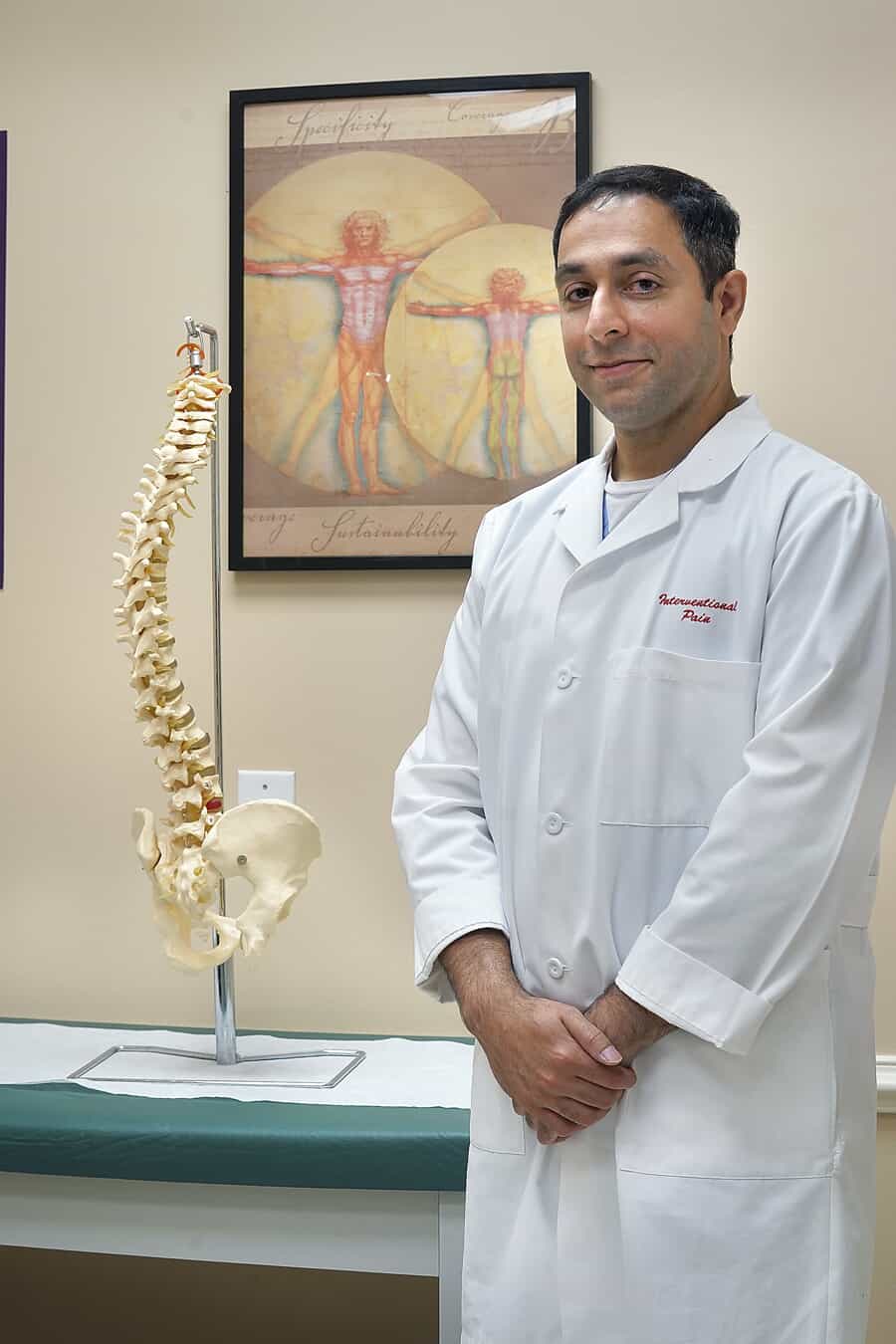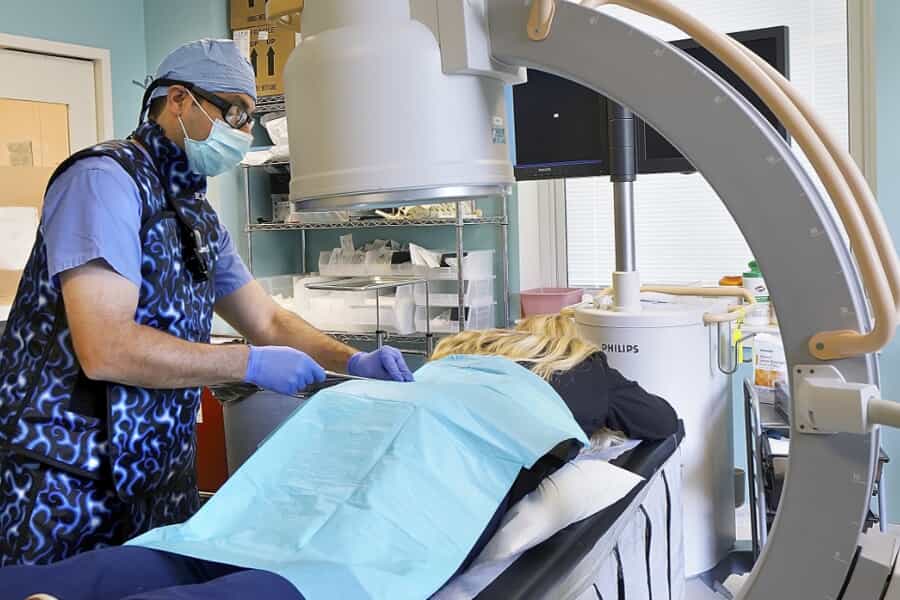Breakthroughs In Pain Relief
- Category: Primary Care
- Posted On:

Rehan Waheed, Do, Who Joined The Team At Valley Health In 2020, Offers Minimally Invasive Treatments That Provide Welcome Relief From Chronic Pain
As anyone with chronic pain can attest, the relentless suffering can completely disrupt your life. Rehan Waheed, DO, a nationally recognized pain specialist, remembers a heartbreaking conversation with a farmer who had debilitating foot pain that was partly nerve-based. The farmer, who thought he might have to sell his farm, told Dr. Waheed: “I can’t live like this anymore. I’ve tried everything under the sun—every medication, every injection.”
 But Dr. Waheed had an innovative tool in his arsenal. He is among a handful of physicians who use an exciting technology called neuromodulation to treat pain. A technique that directly targets the nervous system with electrical pulses, neuromodulation is a highly effective and safe method of relieving chronic pain. “Pain is, at its core, a nervous system response to stimulus in the body that is experienced in the brain,” explains Dr. Waheed, who joined the Valley Health team in May. “When some part of your body senses pain, the response is to tell your brain, ‘this hurts.’ ” But when the body’s efforts to send that message are altered—or modulated—by an implantable device that sends signals to the nerves, it can change the way the nerves respond to pain. To help the farmer, Dr. Waheed used a type of neuromodulation known as dorsal root ganglion (DRG) stimulation. The treatment—which can be used for neuropathic pain (primarily pain from nerve damage or nervous system injury) in the foot, knee or hip, and even for people who’ve had shingles with nerve pain that remains after the shingles rash has subsided— begins with a five- to seven-day trial period. During the trial, an external pulse generator is connected to thin, insulated electrical leads that are positioned on the dorsal root ganglia nerves in the spine. As a result, the body’s pain signals are interrupted and the perception of pain is dramatically altered. After the trial period with the external pulse generator, the farmer reported being happy with the results (as do a vast majority of Dr. Waheed’s patients) and chose to have a permanently implanted pulse generator. During the implant procedure, the pulse generator is placed under the skin and includes a battery that is rechargeable via Bluetooth. “DRG changed his life,” says Dr. Waheed. “He’s doing great. He’s minding his fields, and he’s relatively pain-free.”
But Dr. Waheed had an innovative tool in his arsenal. He is among a handful of physicians who use an exciting technology called neuromodulation to treat pain. A technique that directly targets the nervous system with electrical pulses, neuromodulation is a highly effective and safe method of relieving chronic pain. “Pain is, at its core, a nervous system response to stimulus in the body that is experienced in the brain,” explains Dr. Waheed, who joined the Valley Health team in May. “When some part of your body senses pain, the response is to tell your brain, ‘this hurts.’ ” But when the body’s efforts to send that message are altered—or modulated—by an implantable device that sends signals to the nerves, it can change the way the nerves respond to pain. To help the farmer, Dr. Waheed used a type of neuromodulation known as dorsal root ganglion (DRG) stimulation. The treatment—which can be used for neuropathic pain (primarily pain from nerve damage or nervous system injury) in the foot, knee or hip, and even for people who’ve had shingles with nerve pain that remains after the shingles rash has subsided— begins with a five- to seven-day trial period. During the trial, an external pulse generator is connected to thin, insulated electrical leads that are positioned on the dorsal root ganglia nerves in the spine. As a result, the body’s pain signals are interrupted and the perception of pain is dramatically altered. After the trial period with the external pulse generator, the farmer reported being happy with the results (as do a vast majority of Dr. Waheed’s patients) and chose to have a permanently implanted pulse generator. During the implant procedure, the pulse generator is placed under the skin and includes a battery that is rechargeable via Bluetooth. “DRG changed his life,” says Dr. Waheed. “He’s doing great. He’s minding his fields, and he’s relatively pain-free.”
Meet Dr. Waheed
Dr. Waheed, who speaks nationally on neuromodulation, brings expertise in several exciting chronic pain treatments to the Northern Shenandoah Valley. After becoming a lawyer, he got interested in healthcare policy and switched gears, enrolling in medical school. (Perhaps medicine is in his blood; his father was a pulmonologist and his older brother is a surgeon.) While DRG is a more targeted technique, people suffering from a diffuse pain syndrome like radiculopathy— pain in the neck and lower back that spreads down the arms and legs—might benefit from traditional spinal cord stimulation. During this treatment, the spinal cord is stimulated with electrical pulses through a wire lead placed into the spine. “Seventy percent or greater [of patients who receive spinal cord stimulation] experience enough pain relief that they would repeat the procedure again,” Dr. Waheed says.
Spinal cord stimulation helps treat headache pain; trigeminal neuralgia, or stabbing pain in the face; syndromes that cause foot or hand pain; and pain caused by diabetic neuropathy. The two-part treatment, performed in a doctor’s office or outpatient surgery center, also begins with a five- to seven-day trial, followed by permanent implantation. “For the trial procedure, no incisions are required,” Dr. Waheed says. “The lead is simply inserted using a needle, which is advanced into the appropriate space. The battery can also be surgically implanted or worn in an article of clothing, based on patient preference.”
Another highly focused use of neuromodulation is called peripheral nerve stimulation (PNS), a technique that has seen significant advances over the years. During this procedure, a lead is placed directly over a nerve in a hand, arm, shoulder, or foot. Doctors used to permanently implant the wires, but today, an electronic pulsing device is used temporarily. “I place the lead there for 60 days and then remove it in the office, and the pain relief may last up to one to two years,” Dr. Waheed says. “It’s like a 60-day retraining of the nerve.” The procedure helps with troubles like post-amputation pain, chronic shoulder pain and postoperative knee pain.
Targeted Use Of Pain Medications
 In addition to neuromodulation, Dr. Waheed offers game-changing ways to effectively deliver targeted pain medication. One of his patients, a young woman who was a cancer survivor, couldn’t walk because she still suffered from severe pain all over her body. “She was on high-dose opioid pain patches and oral medication, and said, ‘[They] constipate me and make me sleepy, and I’m not sure that they’re helping,’ ” Dr. Waheed recalls. He recommended an intrathecal pain pump (IPP), which is implanted to deliver relief using less medication. “This pain pump, the size of a hockey puck, has a catheter that pumps medication directly into your spine,” he says. “We can use just micrograms of medication and cause profound pain relief.”
In addition to neuromodulation, Dr. Waheed offers game-changing ways to effectively deliver targeted pain medication. One of his patients, a young woman who was a cancer survivor, couldn’t walk because she still suffered from severe pain all over her body. “She was on high-dose opioid pain patches and oral medication, and said, ‘[They] constipate me and make me sleepy, and I’m not sure that they’re helping,’ ” Dr. Waheed recalls. He recommended an intrathecal pain pump (IPP), which is implanted to deliver relief using less medication. “This pain pump, the size of a hockey puck, has a catheter that pumps medication directly into your spine,” he says. “We can use just micrograms of medication and cause profound pain relief.”
Newer nonopioid medications can be used with the pump, which Dr. Waheed calls a game-changer. A physician or nurse controls the dosages via Bluetooth, or the pump can be programmed so patients with severe pain can safely give themselves doses of medication controlled in quantity by a physician throughout the day. The pump allowed Dr. Waheed’s cancer patient to cut way back on her oral medications. “She can now walk around in the office when she sees me,” he says. “She uses a wheelchair for longer periods, but it’s a complete 180 from the direction she was going.” As a pain specialist who uses state-of-the-art tools, Dr. Waheed has helped patients who thought they were out of options find relief and get back to their lives. “I have patients who couldn’t easily move or walk because of back pain and leg pain, and it’s been drastically reduced with these new treatments. They can be life changing.”
Do you suffer from chronic pain? Ask your physician for a referral or contact our office at 540-450-2339.


